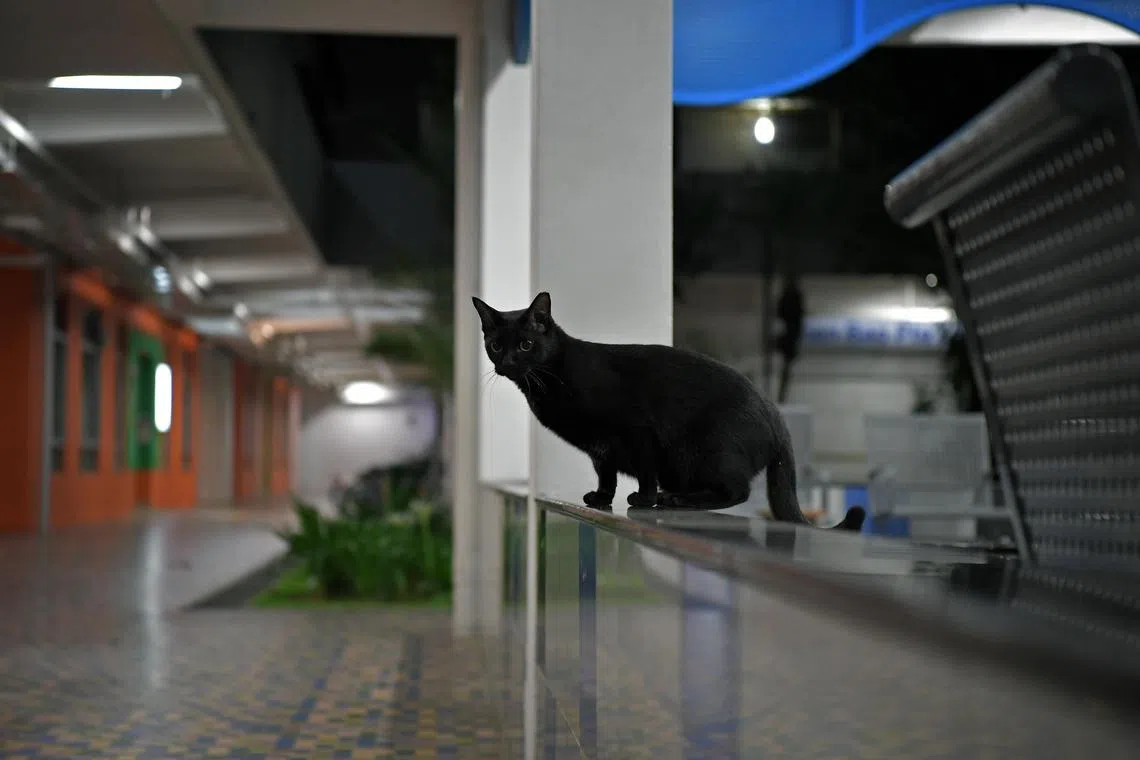Boredom, exposure to domestic violence among reasons people abuse animals: Experts
Sign up now: Get ST's newsletters delivered to your inbox

SPCA said 2023 has seen a “disproportionately high number” of cat abuse cases.
PHOTO: ST FILE
Follow topic:
SINGAPORE - From amusement to displacement of anger, psychologists say people abuse animals for a wide variety of reasons.
Promises Healthcare senior forensic psychologist June Fong told The Straits Times that some people abuse animals to relieve negative feelings like loneliness and frustration. Others do it as a form of retaliation, against the animal or its owner.
In December 2022, a cat died after a boy allegedly threw it off the 22nd storey of a Housing Board block in Boon Lay.
Recently, a teenage boy was arrested after a video showing him trying to perform obscene acts on a tabby cat
The Society for the Prevention of Cruelty to Animals (SPCA) said 2023 has seen a “disproportionately high number” of cat abuse cases. It investigated 11 such cases from January to March.
In comparison, it probed 16 cases in the whole of 2022 and 11 cases in 2021.
These instances of young people abusing animals could be due to boredom or a desire to seek thrills, but Ms Fong said that a history of domestic violence and childhood abuse could also play a part.
“If a child has witnessed someone torturing an animal or hurting someone else without consequence, they learn that it is not wrong to hurt another person or animal,” she said.
And while both youth and adults may experience similar urges of hurting an animal, Ms Fong said young people tend to be more impulsive, being less capable of exerting the necessary self-control or mental reasoning to rein in those urges.
“The youth may also lack the ability to think about long-term consequences. They may see animals as an ‘easier’ target, especially so for stray animals, as they might think that nobody will notice if something happens to the animals,” she said.
Dr Annabelle Chow, clinical psychologist at Annabelle Psychology, said some young people may engage in sexual behaviour with animals out of curiosity or to seek affection, but there are other factors, such as intellectual impairment.
She also noted that there are links between being a victim or witness of sexual abuse in childhood and engaging in animal sexual abuse.
“Childhood victims who experience such traumatic events are at higher risk of committing animal and sexual abuse in later life,” said Dr Chow.
Ms Lynn Tan, clinical psychologist at The Psychology Practice, said that among many reasons, individuals may also hurt animals to impress their friends or for entertainment.
She noted that while there are no local numbers indicating that cats are more susceptible to abuse compared with dogs, cats may remain targets of abuse owing to their smaller size, accessibility, and some of their behaviour traits, such as responses when being attacked.
The views people may have about cats, including their perceived “invulnerability” derived from the saying that cats have nine lives, or beliefs about black cats and luck or attitudes towards strays, may have contributed to them being targets, she added.
The correlation between animal abuse and domestic violence has been termed “The Link”. The website of the Animal Legal Defence Fund, an American animal-advocacy organisation, cites several studies that have found a direct link between acts of cruelty to animals and violence towards people.
Among the studies cited is a landmark one in 1997 by the Massachusetts Society for the Prevention of Cruelty to Animals and Northeastern University, which found that animal abusers were five times as likely to also harm other humans.
Another study, published 10 years ago, found that 43 per cent of those who committed school massacres also committed acts of cruelty to animals – generally against cats and dogs.
But psychologists say that while animal abusers are likely to commit other violent acts, they may not necessarily grow up to be criminals.
Ms Fong said it is likely that animal cruelty is symptomatic of anti-social behaviour, which stems from underlying causes, including being exposed to familial or peer violence. This in turn makes abusers more prone to potentially engaging in violent or aggressive acts, she said.
Ms Tan said it does not mean that animal abusers will grow up perpetuating violence, although such past behaviour is a risk factor.
“It goes back to understanding the motivators and the underlying reasons why this person abused animals in the first place,” she said.
“With that, we probably have a more nuanced understanding of the level of risk a person might carry in adulthood.”
At the same time, intervention is necessary, said Dr Chow. “To help correct such behaviour, it is important that we first understand the motivations behind such cruelty.”
While she is not aware of any direct evidence that animal abusers will go on to commit more serious crimes, there is a strong link between the severity of animal abuse and violence or aggression.
“Animal abusers who do not receive intervention are likely to continue engaging in these behaviours, with the severity and frequency possibly increasing over time,” she said, noting that the approach with young people to correct such behaviour is different.
“As parents and adults, we must approach our children’s acts of cruelty with kindness and compassion. Studies of animal abuse by children find that most mistreatment is unintentional, motivated by curiosity, and infrequent,” Dr Chow said.
Consistent public education on animal abuse is also a way to help prevent such behaviour, Ms Fong said, adding that mere punishment and shaming the abuser without giving them the tools to rehabilitate is futile.
Ms Fong said that given how animal abuse is linked to human violence and criminality in general, animal abuse is not only an animal welfare problem but also a social problem.
“If left unaddressed, such acts might perpetuate the notion that animals are lesser beings and, therefore, justified targets of aggression or even neglect,” she said.
In the same vein, Ms Tan said the prevalence of animal abuse is a threat to societal values.
“We need to speak about animal cruelty and have wider conversations on how our current systems affect prevailing attitudes towards groups that may be different from us. Are we doing justice in building an inclusive society that respects life equally?”


